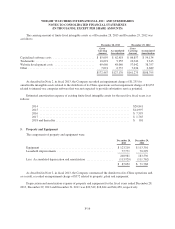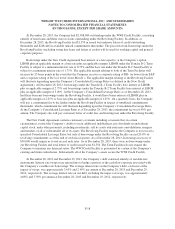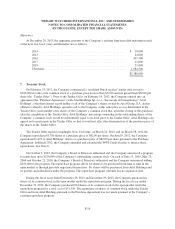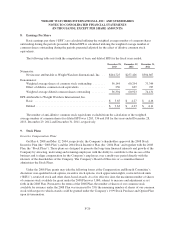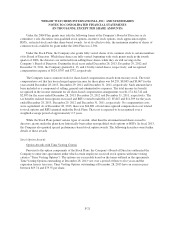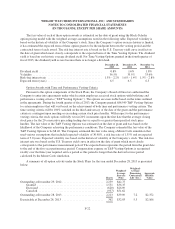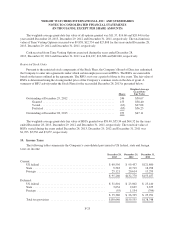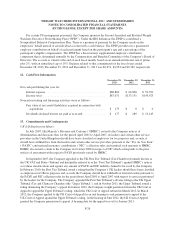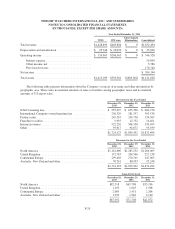WeightWatchers 2013 Annual Report Download - page 112
Download and view the complete annual report
Please find page 112 of the 2013 WeightWatchers annual report below. You can navigate through the pages in the report by either clicking on the pages listed below, or by using the keyword search tool below to find specific information within the annual report.
WEIGHT WATCHERS INTERNATIONAL, INC. AND SUBSIDIARIES
NOTES TO CONSOLIDATED FINANCIAL STATEMENTS
(IN THOUSANDS, EXCEPT PER SHARE AMOUNTS)
For certain US management personnel, the Company sponsors the Second Amended and Restated Weight
Watchers Executive Profit Sharing Plan (“EPSP”). Under the IRS definition, the EPSP is considered a
Nonqualified Deferred Compensation Plan. There is a promise of payment by the Company made on the
employees’ behalf instead of an individual account with a cash balance. The EPSP provides for a guaranteed
employer contribution on behalf of each participant based on the participant’s age and a percentage of the
participant’s eligible compensation. The EPSP has a discretionary supplemental employer contribution
component that is determined annually by the Compensation and Benefits Committee of the Company’s Board of
Directors. The account is valued at the end of each fiscal month, based on an annualized interest rate of prime
plus 2%, with an annualized cap of 15%. Expense related to this commitment for the fiscal years ended
December 28, 2013, December 29, 2012 and December 31, 2011 was $2,651, $2,954 and $2,369, respectively.
12. Cash Flow Information
December 28,
2013
December 29,
2012
December 31,
2011
Net cash paid during the year for:
Interest expense ........................................ $88,860 $ 68,808 $ 52,591
Income taxes .......................................... $87,071 $133,131 $144,925
Noncash investing and financing activities were as follows:
Fair value of net assets/(liabilities) acquired in connection with
acquisitions ......................................... $ 175 $ 0 $ 0
Dividends declared but not yet paid at year-end ............... $ 177 $ 289 $ 13,145
13. Commitments and Contingencies
UK Self-Employment Matter
In July 2007, Her Majesty’s Revenue and Customs (“HMRC”) issued to the Company notices of
determination and decisions that, for the period April 2001 to April 2007, its leaders and certain other service
providers in the United Kingdom should have been classified as employees for tax purposes and, as such, it
should have withheld tax from the leaders and certain other service providers pursuant to the “Pay As You Earn”
(“PAYE”) and national insurance contributions (“NIC”) collection rules and remitted such amounts to HMRC.
HMRC also issued a claim to the Company in October 2008 in respect of NIC which corresponds to the prior
notices of assessment with respect to PAYE previously raised by HMRC.
In September 2007, the Company appealed to the UK First Tier Tribunal (Tax Chamber) (formerly known as
the UK VAT and Duties Tribunal and hereinafter referred to as the “First Tier Tribunal”) against HMRC’s notices
as to these classifications and against any amount of PAYE and NIC liability claimed to be owed by the Company.
In February 2010, the First Tier Tribunal issued a ruling that the Company’s UK leaders should have been classified
as employees for UK tax purposes and, as such, the Company should have withheld tax from its leaders pursuant to
the PAYE and NIC collection rules for the period from April 2001 to April 2007 with respect to services performed
by the leaders for the Company. The Company appealed the First Tier Tribunal’s adverse ruling to the UK Upper
Tribunal (Tax and Chancery Chamber) (the “Upper Tribunal”), and in October 2011, the Upper Tribunal issued a
ruling dismissing the Company’s appeal. In January 2012, the Company sought permission from the UK Court of
Appeal to appeal the Upper Tribunal’s ruling, which the UK Court of Appeal refused in March 2012. In March
2012, the Company applied to the UK Court of Appeal for an oral hearing to seek permission to appeal to the
UK Court of Appeal against the Upper Tribunal’s ruling. At the hearing in June 2012, the UK Court of Appeal
granted the Company permission to appeal. A hearing date for the appeal was set for January 2013.
F-26


